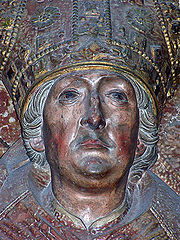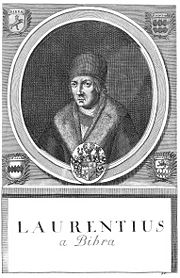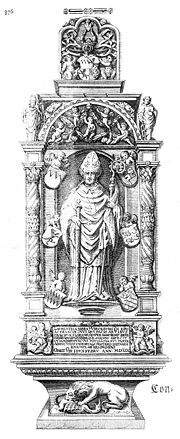
Lorenz von Bibra
Encyclopedia




Franconia
Franconia is a region of Germany comprising the northern parts of the modern state of Bavaria, a small part of southern Thuringia, and a region in northeastern Baden-Württemberg called Tauberfranken...
(1459–1519) was Prince-Bishop
Prince-Bishop
A Prince-Bishop is a bishop who is a territorial Prince of the Church on account of one or more secular principalities, usually pre-existent titles of nobility held concurrently with their inherent clerical office...
of the Bishopric of Würzburg
Bishopric of Würzburg
The Bishopric of Würzburg was a prince-bishopric in the Holy Roman Empire, located in Lower Franconia, around the city of Würzburg, Germany. Würzburg was a diocese from 743. In the 18th century, its bishop was often also Bishop of Bamberg...
from 1495 to 1519. His life paralleled Maximilian I
Maximilian I, Holy Roman Emperor
Maximilian I , the son of Frederick III, Holy Roman Emperor and Eleanor of Portugal, was King of the Romans from 1486 and Holy Roman Emperor from 1493 until his death, though he was never in fact crowned by the Pope, the journey to Rome always being too risky...
(1459–1519), who served as Holy Roman Emperor from 1493 to 1519, to which Lorenz did serve as an advisor.
Biography
Born in 1459, he attended school at Vessra AbbeyVessra Abbey
Vessra Abbey was a Premonstratensian monastery in the village also named Kloster Veßra in the district of Hildburghausen, Thuringia, Germany....
and university at Heidelberg
Heidelberg
-Early history:Between 600,000 and 200,000 years ago, "Heidelberg Man" died at nearby Mauer. His jaw bone was discovered in 1907; with scientific dating, his remains were determined to be the earliest evidence of human life in Europe. In the 5th century BC, a Celtic fortress of refuge and place of...
, Erfurt
Erfurt
Erfurt is the capital city of Thuringia and the main city nearest to the geographical centre of Germany, located 100 km SW of Leipzig, 150 km N of Nuremberg and 180 km SE of Hannover. Erfurt Airport can be reached by plane via Munich. It lies in the southern part of the Thuringian...
, and Paris
Paris
Paris is the capital and largest city in France, situated on the river Seine, in northern France, at the heart of the Île-de-France region...
. In 1487 he wrote a letter of introduction to Pope Innocent VIII
Pope Innocent VIII
Pope Innocent VIII , born Giovanni Battista Cybo , was Pope from 1484 until his death.-Early years:Giovanni Battista Cybo was born at Genoa of Greek extraction...
for his half brother Wilhelm who was being sent to the Vatican as emissary of Archbishop Hermann IV of Cologne
Cologne
Cologne is Germany's fourth-largest city , and is the largest city both in the Germany Federal State of North Rhine-Westphalia and within the Rhine-Ruhr Metropolitan Area, one of the major European metropolitan areas with more than ten million inhabitants.Cologne is located on both sides of the...
. In 1490, Wilhelm became ill when returning from Rome
Rome
Rome is the capital of Italy and the country's largest and most populated city and comune, with over 2.7 million residents in . The city is located in the central-western portion of the Italian Peninsula, on the Tiber River within the Lazio region of Italy.Rome's history spans two and a half...
as an emissary of Frederick III, Holy Roman Emperor
Frederick III, Holy Roman Emperor
Frederick the Peaceful KG was Duke of Austria as Frederick V from 1424, the successor of Albert II as German King as Frederick IV from 1440, and Holy Roman Emperor as Frederick III from 1452...
. The grave of Wilhelm von Bibra is still to be seen in the Pelligrini Chapel of the Saint Anastasia Church in Verona
Verona
Verona ; German Bern, Dietrichsbern or Welschbern) is a city in the Veneto, northern Italy, with approx. 265,000 inhabitants and one of the seven chef-lieus of the region. It is the second largest city municipality in the region and the third of North-Eastern Italy. The metropolitan area of Verona...
.
Lorenz was a popular and well respected ruler. He was often called upon to serve as an arbitrator to solve disputes. An adherent of the German humanism movement
Humanism in Germany
Renaissance Humanism came much later to Germany and Northern Europe in general than to Italy, and when it did, it encountered some resistance from the scholastic theology which reigned at the universities.-Origins:...
of the late 15th and early 16th centuries and renaissance man, he sought to bring reforms to the Catholic Church from within.
Meeting with Luther and letter to Frederick the Wise
Lorenz met with and got along well with Martin LutherMartin Luther
Martin Luther was a German priest, professor of theology and iconic figure of the Protestant Reformation. He strongly disputed the claim that freedom from God's punishment for sin could be purchased with money. He confronted indulgence salesman Johann Tetzel with his Ninety-Five Theses in 1517...
. Luther arrived on April 18, 1518 in Würzburg with a letter of introduction from Duke Frederick the Wise of Saxony. Lorenz offered a new escort accompany him to Heidelberg. Luther turned down the offer as Luther’s Erfut brethren, Land and Usingen
Bartholomaeus Arnoldi
Bartholomaeus Arnoldi was an Augustinian friar and doctor of divinity who taught Martin Luther and later turned into his earliest and one of his personally closest opponents.-Life:...
, met him and offered a ride on their cart. This was right before Luther's disputes with the Catholic Church heated up and right before Lorenz died in 1519. Following the meeting in Würzburg, Lorenz wrote a letter of recommendation to Duke Frederick the Wise of Saxony stating:
George Spalatin
George Spalatin
Georg Spalatin was the pseudonym taken by Georg Burkhardt , an important German figure in the history of the Reformation....
wrote:
Speculation by historians, what if Lorenz had lived longer
Frederick the Wise was the second most powerful man in the Holy Roman Empire and became Luther's greatest protector and champion during the Reformation. This letter has helped fuel speculation over Lorenz's sympathies. Baier reports that the historians von SeckendorffVeit Ludwig von Seckendorff
Veit Ludwig von Seckendorf , German statesman and scholar, was a member of a German noble family, which took its name from the village of Seckendorf between Nuremberg and Langenzenn....
, Lingke, Strobel, Walch, Engelhardt, Vierort, Tentzel, Löhe
Johann Konrad Wilhelm Löhe
Johann Konrad Wilhelm Löhe was a pastor of the Lutheran Church, Neo-Lutheran writer, and is often regarded as being a founder of the deaconess movement in Lutheranism and a founding sponsor of the Lutheran Church - Missouri Synod . He was a pastor in nineteenth-century Germany...
, Shornbaum and Köstlin (in contrast to Scharold) agreed with Splatin that had Lorenz lived longer, the Episcopate of Würzburg would have gone over to the Protestants.
Baier quotes Splatin:
Luther’s comments on Lorenz’ views on monasteries and convents
Bair quotes also quotes Splatin:An incident that occurred while Luther traveled through Würzburg was later commented on by Luther. Some young Domherren (members of the cathedral chapter) took part in a terrible fight among themselves whereby one of them lost his hand. Lorenz “jailed” them in a monastery. Luther later commented:
Pilgrimages to Grimmenthal
A chapel at GrimmenthalObermaßfeld-Grimmenthal
Obermaßfeld-Grimmenthal is a municipality in the district Schmalkalden-Meiningen, in Thuringia, Germany.-Martin Luther criticism of pilgrimages to Grimmenthal:...
was erected by a Würzburg Captain which was dedicated by the Suffragan bishop
Suffragan bishop
A suffragan bishop is a bishop subordinate to a metropolitan bishop or diocesan bishop. He or she may be assigned to an area which does not have a cathedral of its own.-Anglican Communion:...
of Lorenz, Georg von Bipolis, on August 24, 1498. The number of pilgrims grew so much and the money came in so abundantly that a bigger church had to be built by the chapel which was inaugurated on May 1, 1502. Luther had nothing nice to say about this:
Present day influences
The exchange between Luther and Lorenz was the inspiration of a short two scene play, Luther bei Lorenz von Bibra, by Deacon Dr. Günter Breitenbach of the Evangelical Church in GermanyEvangelical Church in Germany
The Evangelical Church in Germany is a federation of 22 Lutheran, Unified and Reformed Protestant regional church bodies in Germany. The EKD is not a church in a theological understanding because of the denominational differences. However, the member churches share full pulpit and altar...
, in September 2007 and performed October 2, 2007 at the Augustinerkirche in Würzburg with Dr. Breitenbach in the role of Lorenz von Bibra and Catholic Augustinian
Augustinians
The term Augustinians, named after Saint Augustine of Hippo , applies to two separate and unrelated types of Catholic religious orders:...
Provinzprokurator Br. Peter Reinl OSA in the role of Luther.
Lorenz von Bibra and Riemenschneider
Contrary to his successor, Lorenz also had good relations with the famous sculptor Tilman RiemenschneiderTilman Riemenschneider
Tilman Riemenschneider was a German sculptor and woodcarver active in Würzburg from 1483. He was one of the most prolific and versatile sculptors of the transition period between late Gothic and Renaissance, a master in stone and limewood.- Biography :Tilman Riemenschneider was born between 1459...
who at a time also served as mayor of Würzburg. Lorenz commissioned him to make an alter for the new church in Bibra. Lorenz also commissioned Riemenschneider to do both his predecessor's, Rudolf von Scherenberg
Rudolf von Scherenberg
Rudolf II von Scherenberg was Bishop of Würzburg from 1466 until his death.Rudolf von Scherenberg was the son of Erhard von Scherenberg and Anna von Massbach. On April 30, 1466, he was appointed as bishop to replace Johann von Grumbach. He was confirmed as bishop on June 20, 1466...
,and his own grave marker in the cathedral in Würzburg. Today, the two gravestones stand side by side, same stone and motif, but in two different styles, late gothic and renaissance.
Lorenz von Bibra and Trithemius
Johannes TrithemiusJohannes Trithemius
Johannes Trithemius , born Johann Heidenberg, was a German abbot, lexicographer, historian, cryptographer, polymath and occultist who had an influence on later occultism. The name by which he is more commonly known is derived from his native town of Trittenheim on the Mosel in Germany.-Life:He...
(1 February 1462 - 13 December 1516) in 1506 decided to take up the offer of the of Lorenz von Bibra to become abbot of the St. Jakob zu den Schotten
St. James's Abbey, Würzburg
St. James's Abbey was a Benedictine monastery in Würzburg. It was founded as a Scotch monastery by Embrico, Bishop of Würzburg, about 1134.-History:...
, the Schottenklöster
Hiberno-Scottish mission
The Hiberno-Scottish mission was a mission led by Irish and Scottish monks which spread Christianity and established monasteries in Great Britain and continental Europe during the Middle Ages...
("Scottish monastery") in Würzburg. The word steganography
Steganography
Steganography is the art and science of writing hidden messages in such a way that no one, apart from the sender and intended recipient, suspects the existence of the message, a form of security through obscurity...
is taken from his book Steganographia, a treatise on cryptography
Cryptography
Cryptography is the practice and study of techniques for secure communication in the presence of third parties...
and steganography
Steganography
Steganography is the art and science of writing hidden messages in such a way that no one, apart from the sender and intended recipient, suspects the existence of the message, a form of security through obscurity...
disguised as a book on black magic
Black magic
Black magic is the type of magic that draws on assumed malevolent powers or is used with the intention to kill, steal, injure, cause misfortune or destruction, or for personal gain without regard to harmful consequences. As a term, "black magic" is normally used by those that do not approve of its...
and his book Polygraphia (1518) was the first printed book on cryptography.
von Bibra Family
It has been noted that Lorenz appointed a very large number of his Bibra relatives to government positions in the Bishopric of WürzburgBishopric of Würzburg
The Bishopric of Würzburg was a prince-bishopric in the Holy Roman Empire, located in Lower Franconia, around the city of Würzburg, Germany. Würzburg was a diocese from 743. In the 18th century, its bishop was often also Bishop of Bamberg...
and that his successor, Konrad II von Thungen, also followed this same pattern but to an even greater degree.
Lorenz was a member of the aristocratic Franconian von Bibra family which among its members were Lorenz’ half brother, Wilhelm von Bibra
Wilhelm von Bibra
Wilhelm von Bibra was a Papal Emissary.-Papal Emissary:Wilhelm functioned as a Papal Emissary for both the archbishop of Cologne and Kaiser Friedrich. Wilhelm’s half brother, Prince Bishop Lorenz von Bibra of Würzburg, in 1487 wrote a letter of introduction to Pope Innocent VIII for Wilhelm who...
Papal emissary, Conrad von Bibra
Conrad von Bibra
Conrad von Bibra , Duke in Franconia was Prince-Bishop of Würzburg from 1540 to 1544. -Biography:...
, Prince-Bishop of Würzburg, Duke in Franconia
Franconia
Franconia is a region of Germany comprising the northern parts of the modern state of Bavaria, a small part of southern Thuringia, and a region in northeastern Baden-Württemberg called Tauberfranken...
(1490–1544), Heinrich von Bibra
Heinrich von Bibra
Heinrich von Bibra , Prince-Bishop, Prince-Abbot of Fulda was Prince-Bishop from 1759 to 1788.-Biography:...
, Prince-Bishop, Prince-Abbot of Fulda
Fulda
Fulda is a city in Hesse, Germany; it is located on the river Fulda and is the administrative seat of the Fulda district .- Early Middle Ages :...
(1711–1788) and Ernst von Bibra
Ernst von Bibra
Dr. Ernst Freiherr von Bibra was a German Naturalist and author...
(* 1806 ; † 1878), naturalist and author.

